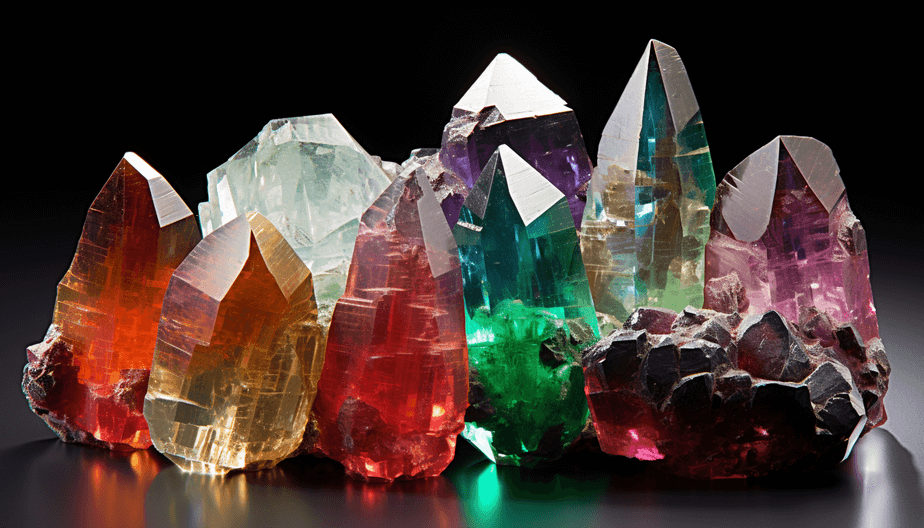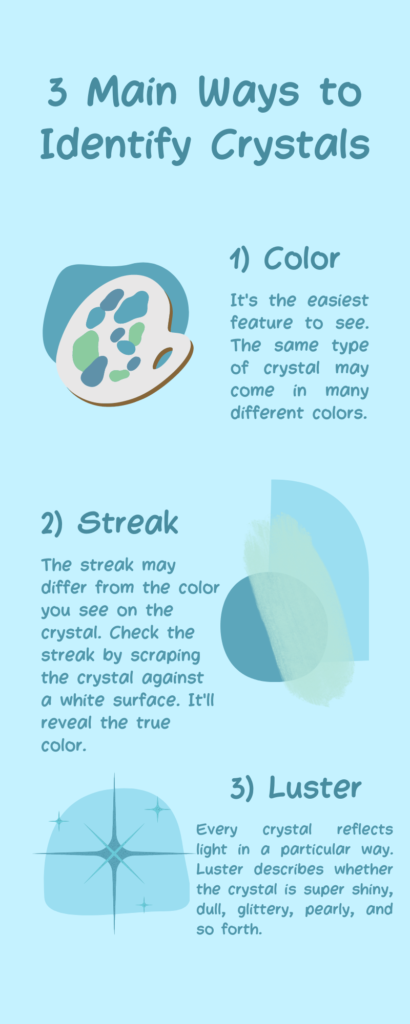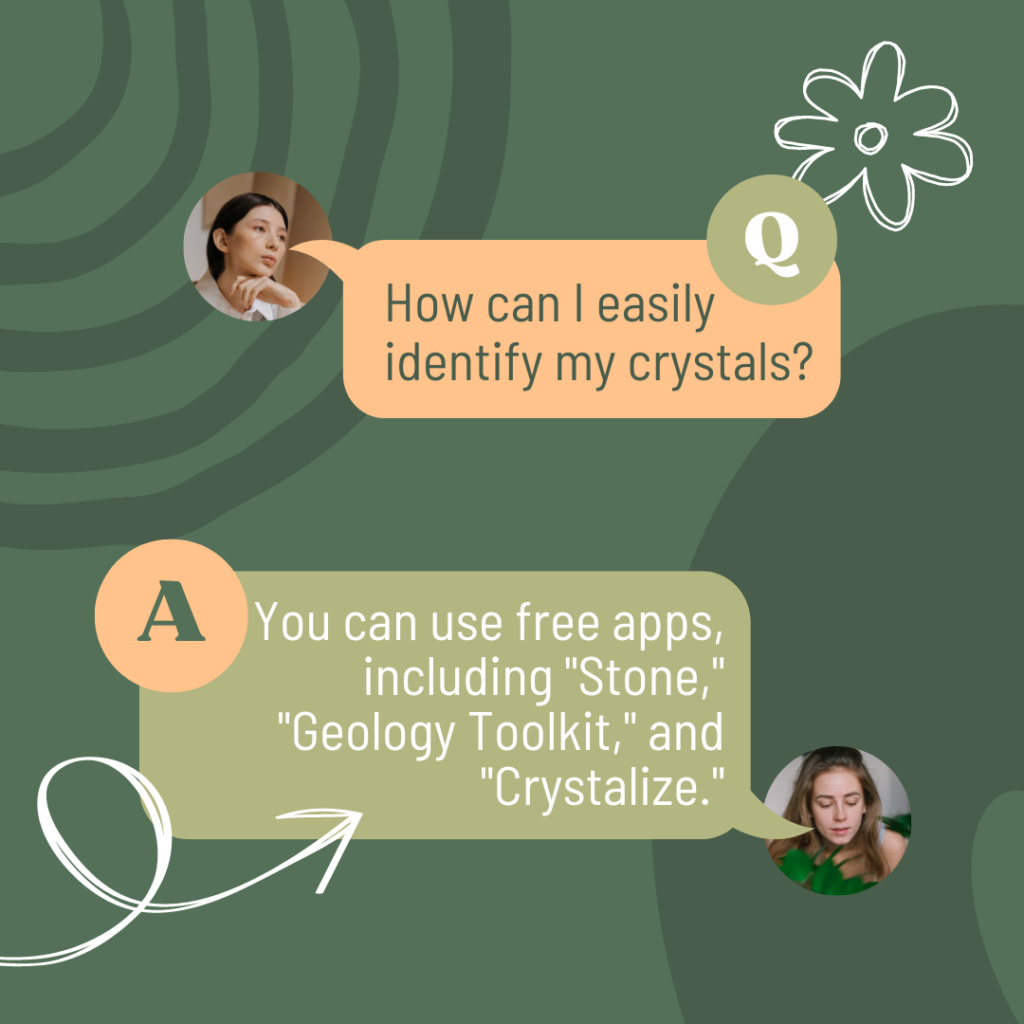
The world of crystals is as wide as the range of colors each stone can paint. This vast array can make crystal identification intimidating. Rhodonite, mookaite, quartz, aventurine, the list goes on! How do you know which is which? What is the best way to identify crystals?
Crystals can be identified by factors including their color, streak, and luster. You can use a crystal identification guide to recognize your crystals or use a handy crystal identification app.
Learn how to identify crystals with the crystal identification guide below, and reference the identification chart and top-rated apps to make the process easy.
Crystal Identification Guide
Identification involves inspecting a crystal’s chemical compositions, patterns, and colors. There’s an entire division of science dedicated to examining crystals called crystallography.
Based on this science, cells within each crystal form a geometric pattern. Such patterns fall into seven classifications: isometric, trigonal, hexagonal, tetragonal, orthorhombic, monoclinic, and triclinic.
However, unless you’re an expert crystallographer, it’s probably easier to identify crystals by color, streak, and luster.

Color
Color is the most distinctive feature of any crystal. Sometimes, one crystal will contain the whole rainbow (see Rainbow Moonstone or Rainbow Flourite).
As you’ll see, one type of crystal can also exist in different colors. For example, quartz can be yellow, blue, or rose-colored. In these cases, the crystal has a different chemical composition, creating a new color.
Streak
So, how do you determine a crystal’s actual color? An easy way to accomplish this is to rub or grate the crystal on a white surface to produce a powder called its streak. This crystal powder will identify the crystal’s authentic color.
Luster
To put it simply, how shiny does the crystal appear? Luster describes how light glances off of the crystal’s surface.
Some crystals appear glassy, while others sparkle and shimmer. Some are non-reflective or dull. All of these descriptions will help you identify the crystal in question.
| Luster Term | Meaning |
|---|---|
| Adamantine | Glittery |
| Earthy | Muted, non-reflective |
| Pearly | Shimmers like a pearl |
| Resinous | Looks like tree sap |
| Silky | Soft appearance; waxy |
| Vitreous | Glassy |
Other Identification Terms
You can also identify crystals by their cleavage and fracture. These two properties describe the way the minerals break. For example, lepidolite mica has cleavage in long planes, causing breakable layers.
How a crystal fractures, or breaks across the cleavage line, can be unique to each crystal. It may break at a 90-degree angle or some other angle.
You can ask and test even more criteria to identify crystals. Is your crystal magnetic? Does it taste salty? Some crystals are fluorescent, meaning they illuminate under ultraviolet rays. Some may give off a metallic smell. You can use nearly all of your senses when identifying a crystal.
MORE:
- Bible about Dinosaurs
- Disciple and apostle
- Do You Have To Be Baptized To Go To Heaven?
- Dreaming About Being Kidnapped
- Easter Festival
Crystal Identification Chart
| Color | Stone | Identifying Factors |
|---|---|---|
| Multi-Colored | Quartz Rose Quartz Smoky Quartz Yellow Quartz Hematoid Quartz Rutilated Quartz Blue Quartz Amethyst (Violet Quartz) Chevron Amethyst (Violent and White Banded Quartz) | Quartz has a transparent, visibly crystalline structure and comes in many colors and color patterns. It might appear cloudy, not completely clear. The angles will always appear prismatic regardless of the size of the quartz crystal. Genuine quartz will scratch household glass. |
| Serpentine Tumbled Serpentine Green Serpentine | Serpentine appears shiny or wax and usually feels like a bar of soap. It can be confused for jade due to its green, gray, or blackish coloration. However, jade appears more vitreous (glassy) than serpentine. | |
| Orange Aventurine Green Aventurine | Aventurine is a type of quartz with a shimmery surface. Having higher iron content leads to an orange hue in some of these crystals. | |
| Pink Rhodonite Dark Rhodonite | Rhodonites are often cut into gemstones due to their lustrous shine and clarity. They come in pink and red hues. | |
| Green Calcite Orange Calcite Red Calcite Blue Calcite | Calcite comes in nearly every color and has a shiny, glassy appearance. Calcite does not fracture evenly, but you can see the crystalline planes when it does. | |
| Web Jasper White Jasper Orange Jasper Ocean Jasper Fancy Jasper Unakite Jasper Polychrome Jasper | Jasper is a mineral that is non-reflective and primarily found in shades of dark red. However, as you can see, it also comes in various colors depending on its mineral composition. It’s finely grained and has no crystalline formations visible to the naked eye. | |
| Black | Black Obsidian | If you have a stone that looks like black swirly glass, you likely have black obsidian. It has sharp edges due to the way it fractures. It’s slightly tougher than your typical window glass. |
| Black Tourmaline | The shape is defined by long crystalline columns. | |
| White | White Howlite | This fractures unevenly, and you can find black spidery patterns across the white surface. |
| White Onyx | It’s characterized by its transparency, waxy texture, and bands of white colors. | |
| White and Gray Apophyllite | It’s glassy or pearly, generally transparent, and breaks across long planes. | |
| Dendritic Opal | White and dark mix beautifully to form random patterns on this crystal. | |
| Tree Agate | The mineral is opaque, white, and has green patterns that appear like tree branches or roots. | |
| Selenite | It’s glassy, translucent, and entirely colorless. | |
| Green | Green Fuschite | This crystal only comes in green and, in rare cases, contains ruby specs. |
| Green Galaxy Stone | This stone, also known as galaxite, is a type of opal that uniquely appears to hold a galaxy. | |
| Nephrite Jade | Jade can come in many colors, but nephrite jade is light to dark green. The colors appear softened. | |
| Amazonite | Though non-reflective, this crystal comes in a bright turquoise shade. Color varieties also include white and gray. | |
| Blue | Blue Apatite | Apatite can come in colors other than blue, some of which are incredibly vivid. It has a brittle, cracked appearance and is opaque. |
| Indigo Gabbro | This is a grainy, dull, opaque rock speckled with dark shades of blue or olive. | |
| Kyanite | This crystal features long blades and blue to black hues. | |
| Sodalite | Blue is the most popular color of this rare mineral. It’s matte and opaque, and the surface often appears cracked. | |
| Orange | Peach Stillbite | They form in clusters and come in a range of oranges. |
| Sun Stone | An iridescent crystal that comes in oranges, golds, and reds. | |
| Tiger Eye | The name describes this crystal’s appearance well; it has luminescent bands, colored in dark orange and brown, which look like cat eyes. | |
| Yellow | Natural Citrine | This gem is shiny, transparent, and colored yellow or brown. |
| Gold Pyrite | This metallic, glossy, brassy stone is also known as fool’s gold. | |
| Mookaite | This is a mix of jasper and opalite. The surface appears dull, and the colors include shades of red, pink, and yellow. | |
| Rainbow | Rainbow Flourite | This crystal offers a streaky, colorful display of greens and purples. It has a full range of transparency. |
| Rainbow Moonstone | Moonstone comes in different colors or no color (clear). It’s an iridescent crystal and may be transparent or opaque (and everything in between). | |
| Labradorite | Its luster is iridescent. The shape is often tubular, and the colors range from grays to blues to dark greens. | |
| Purple | Lepidolite | This stone is dark purple and flaky. |
| Lilac Lepidolite | This is the lighter purple version of lepidolite. | |
| Lepidolite Mica Slice | Shiny, light purple, with weak, thin layers. | |
| Pink | Pink Thulite | They range from pink to red, have a dusty appearance, and are also known as rosaline zoisite. |
| Morganite | Pastel pinks and oranges define this shiny gemstone known for its use in engagement rings. |
Crystal Identification Apps

Whew, you’ve explored a number of crystals by now! Hopefully, you feel adept at identifying crystals. To make it easier on you, though, check out these crystal identification apps.
All of the apps below have free versions. They’ll make the crystal identification process more straightforward than you ever imagined!
Stone
Rating: 4.1 stars out of 477 reviews
This crystal identification app contains a crystal guide and provides insight into each crystal.
Geology Toolkit
Rating: 4.1 stars out of 1.35k reviews
Explore the physical properties of each crystal. This app targets geologists, as well as casual users.
Crystalize
Rating: 4.7 stars out of 1.4k reviews
This app targets individuals who use crystals in their spiritual practice and features an aesthetically pleasing interface. Find crystal guides that include metaphysical properties, numerology, and other spiritual elements alongside physical descriptions.
MORE:
